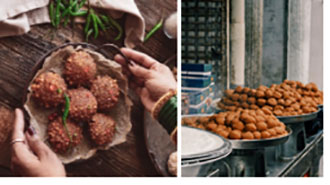India, a land of diverse cultures and cuisines, finds itself as an immense source of food grains, cereals, vegetables, fruits, herbs and spices that play a pivotal role in the country's culinary traditions and economic prosperity. Currently India is the largest producer of spices, milk and pulses. It is the second largest producer of fruits, vegetables, wheat and rice. It is also the fourth largest producer of oilseeds in the world. India receives 2400-3000 hours of sunshine and an average rainfall of 118 cm through the year, with variations depending upon agroclimatic zones. There are 8 agroclimatic zones ranging from humid to arid and seven soil types. This diversity of natural features has led to India being a producer of a great diversity of food and cash crops.

Historical texts and archaeological evidence bear witness to the central role of many of the traditional crops in the evolution of the subcontinent's diet and culture. Oilseeds such as sesame and mustard have been mentioned in ancient scriptures, while the Ayurvedic system of medicine acknowledges the therapeutic properties of various fruits, vegetables and herbs. Chilies were introduced into India by the Portuguese in the 15th century. The potato as we all know is a native South American crop introduced to the rest of the world, including India. Hence these may not be found in ultra traditional ancient recipes but are very popular in the modern Indian cuisine.
India's cultural diversity is profoundly reflected in its preferences of grains cereals vegetables fruits and other components of the diet. Taking oilseeds as another example, different regions of the country have embraced specific oilseeds, shaping their cuisines and culinary identities. For instance, the northern states predominantly use mustard oil, which imparts a distinct pungency to their dishes. In the southern coastal regions, coconut oil is the primary choice, lending a tropical aroma to traditional preparations. The western states favor ground nut oil, while the eastern regions embrace sesame oil for its nutty flavor. India also produces other oilseeds such as soybean, sunflower, Niger seed, and safflower oilseeds.

Hence, traversing this complicated scenario of ingredient, taste, and cooking method preferences for creation of processed foods is fraught.
Being the International Year of Millets 2023, the government is trying to heighten awareness on the consumption and health benefits of millets. Millets have been used in the production of snacks like murukku and pakoras, giving these classic treats a healthy touch. Processed versions of traditional Indian dishes are adjusting to contemporary dietary requirements without sacrificing flavour or cultural heritage by fusing time-honored recipes with millets' nutritional advantages. In addition to becoming a culinary fad, the reappearance of millets in processed versions of traditional Indian foods is a sign of sustainable agricultural methods. Millets are an environmentally friendly option because they endure drought and use less water. These creative millet uses highlight their enduring appeal in the field of processed Indian traditional foods as the importance of sustaining indigenous food traditions and encouraging sustainable agriculture is becoming more widely understood.
F1rst is now hosting its fourth annual Processed Indian Traditional Foods conference, this time around in Bengaluru on the 18th of October 2023 in The Park Hotel, Bengaluru, India where the conference will involve an in-depth examination of methods to increase the demand for processed Indian foods. Furthermore, it will extensively investigate crucial elements, including scientific aspects, vital resources, infrastructure, educational efforts, and the availability of skilled personnel.
In preparation for this conference, it has hosted a series of webinars starting January, once a month covering various aspects of traditional Indian foods in the context of processing a larger social setting. Dr. Vilas Shirhatti -Technical Director from Naturell India Pvt. Ltd., reminded us of the earliest Indian scriptures starting with the Rig veda and continuing through Acharya Susruta’s work (~600BCE), Pakdarpana (~400BCE) and Charakasamhita (~200BCE) which dealt with aspects of nutrition and culinary science until some more modern works. Before mentioning specific examples of foods which could be carriers for nutraceuticals, Dr.Vilas also spoke about the special considerations for intake of foods. The foremost of these is the “prakriti” or “nature” of the food including the “Guna” (Sattvik, Rajasic and Tamasic). It must be noted that the Sattvic council of India has started offering such certification on a voluntary basis and with no involvement from official regulatory agencies.
This conference is sponsored by Ministry ofFood Processing Industries (MoFPI), Tata Consumers Private Limited, and our Associate sponsor is Ross Process Solutions.
(Dr Ramakrishnan is research director at F1rst;
Vidyaeswari R is research analyst at F1rst)